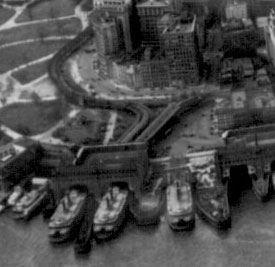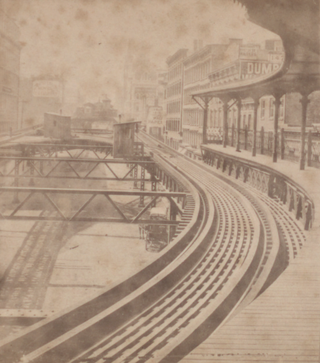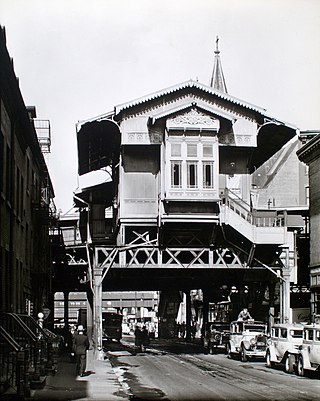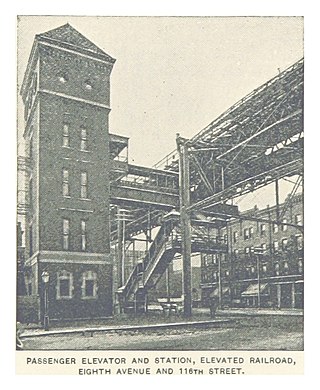Related Research Articles

The IRT Ninth Avenue Line, often called the Ninth Avenue Elevated or Ninth Avenue El, was the first elevated railway in New York City. It opened in July 1868 as the West Side and Yonkers Patent Railway, as an experimental single-track cable-powered elevated railway from Battery Place, at the south end of Manhattan Island, northward up Greenwich Street to Cortlandt Street. By 1879 the line was extended to the Harlem River at 155th Street. It was electrified and taken over by the Interborough Rapid Transit Company in 1903.
The IND Culver Line is a rapid transit line of the B Division of the New York City Subway, extending from Downtown Brooklyn south to Coney Island, Brooklyn, New York City, United States. The local tracks of the Culver Line are served by the F service, as well as the G between Bergen Street and Church Avenue. The express tracks north of Church Avenue are used by the <F> train during rush hours in the peak direction. The peak-direction express track between Ditmas Avenue and Avenue X has not seen regular service since 1987.

The South Ferry station was an elevated station at the southern terminal of the IRT Second, Third, Sixth and Ninth Avenue Lines. It was located next to Battery Park at the lower tip of Manhattan, New York City. Two tracks came from the combined Second and Third Avenue Lines, and two from the Sixth and Ninth Avenue Lines, making four tracks at the terminal, with platforms on the outside and between each pair of tracks.
The 155th Street station was an elevated railway station in Manhattan, New York City, that operated from 1870 until 1958. It served as the north terminal of the IRT Ninth Avenue Line from its opening until 1918 and then as the southern terminal of a surviving stub portion from 1940 until its closure in 1958. It had two tracks and one island platform.

The Ninth Avenue station is a bi-level express station on the BMT West End Line of the New York City Subway, located at the intersection of Ninth Avenue and 39th Street in Brooklyn. Each level has three tracks and two island platforms. The upper level serves the BMT West End Line while the lower level formerly served the BMT Culver Line. Only the upper level is still in service and is served by the D train at all times.

The 161st Street–Yankee Stadium station is a New York City Subway station complex shared by the elevated IRT Jerome Avenue Line and the underground IND Concourse Line. It is located at the intersection of 161st Street and River Avenue in the Highbridge and Concourse neighborhoods of the Bronx. It is generally served by the 4 train at all times; the D train at all times except rush hours in the peak direction ; and the B train weekdays only.

The Fourth Avenue/Ninth Street station is a New York City Subway station complex shared by the elevated IND Culver Line and the underground BMT Fourth Avenue Line. It is located at the intersection of Ninth Street and Fourth Avenue in Park Slope, Brooklyn and served by the:

The 42nd Street station was an elevated express station on the demolished IRT Third Avenue Line in Manhattan, New York City. It had two levels with the lower level having three tracks. The main line tracks were served by two side platforms. A side platform connected to the southbound platform was used for shuttle service to Grand Central. The upper level was built as part of the Dual Contracts, and had one track and two side platforms over the two local tracks.
The Battery Place station was a station on the demolished Ninth Avenue and Sixth Avenue elevated train lines in Manhattan, New York City. It was located at the southern terminus of Greenwich Street at the north end of Battery Park.

The Christopher Street station was an express station on the demolished IRT Ninth Avenue Line in Manhattan in New York City. It had three tracks, one island platform and two side platforms. It was served by trains from the IRT Ninth Avenue Line. It opened on November 3, 1873 and closed on June 11, 1940. On February 25, 1908, the Hudson and Manhattan Railroad built a subway station just east of this station as part of the extension between Hoboken and 33rd Street. The next southbound local stop was Houston Street. The next southbound express stop was Desbrosses Street. The next northbound stop was 14th Street for all trains.
The 14th Street station was an express station on the demolished IRT Ninth Avenue Line in Manhattan, New York City. It had two levels. The lower level was built first and had two tracks and two side platforms. The upper level was built as part of the Dual Contracts and had one track and two side platforms over the lower level local tracks. It closed on June 11, 1940. The next southbound stop was Christopher Street for express and local trains. The next northbound local stop was 23rd Street. The next northbound express stop was 34th Street.
The 66th Street station was an express station on the demolished IRT Ninth Avenue Line in Manhattan, New York City. It had two levels. The lower level was built first and had two tracks and two side platforms. The upper level was built as part of the Dual Contracts and had one track and two side platforms over the lower level local tracks. The station closed on June 11, 1940. The next southbound local stop was 59th Street. The next southbound express stop was 34th Street for Ninth Avenue trains, and 50th Street for IRT Sixth Avenue Line express trains. The next northbound local stop was 72nd Street. The next northbound express stop was 116th Street. The express run from this stop to 116th Street was the longest express segment out of all New York City elevated lines, bypassing seven local stations.

The 42nd Street station was a local station on the demolished IRT Ninth Avenue Line in Manhattan, New York City. It was opened on November 6, 1875, and had two levels. On the lower level, the local trains stopped, on two tracks serving two side platforms. The upper level was built as part of the Dual Contracts and had one track which carried express trains bypassing the station. The next northbound stop was 50th Street. The next southbound stop was 34th Street. The station was closed on June 11, 1940.
The 59th Street station was a local station on the demolished IRT Ninth Avenue Line in Manhattan, New York City. It had two levels. The lower level was built first and had two tracks and two side platforms that served local trains. The upper level was built as part of the Dual Contracts and had one track that served express trains. It closed on June 11, 1940. The next southbound stop was 50th Street for Ninth Avenue trains and Eighth Avenue for IRT Sixth Avenue Line trains. The next northbound stop was 66th Street.
The 86th Street station was a local station on the demolished IRT Ninth Avenue Line in Manhattan, New York City. It had two levels. The lower level was built first and had two tracks and two side platforms and served local trains. The upper level was built as part of the Dual Contracts and had one track that served express trains that bypassed this station. It opened on June 21, 1879 and closed on June 11, 1940. The next southbound stop was 81st Street. The next northbound stop was 93rd Street.
The 99th Street station was a local station on the demolished IRT Ninth Avenue Line in Manhattan, New York City. It had 2 levels. The lower level was built first and had two tracks and two side platforms and served local trains. The upper level was built as part of the Dual Contracts and had one track that served express trains that bypassed this station. It opened on June 21, 1879, and closed on June 11, 1940. The next southbound stop was 93rd Street. The next northbound stop was 104th Street.
The 104th Street station was a local station on the demolished IRT Ninth Avenue Line in Manhattan, New York City. It had two levels. The lower level was built first and had two tracks and two side platforms and served local trains. The upper level was built as part of the Dual Contracts and had one track that served express trains that bypassed this station. It opened on June 21, 1879, and closed on June 11, 1940. The next southbound stop was 99th Street. The next northbound stop was 116th Street station until June 3, 1903, and then 110th Street. This had a view of the Suicide Curve at 110th Street.

The 110th Street station was a local station on the demolished IRT Ninth Avenue Line in Manhattan, New York City. It had two levels. The lower level was built first and had two tracks and two side platforms and served local trains. The upper level was built as part of the Dual Contracts and had one track that served express trains that bypassed this station. It opened on June 3, 1903, and closed on June 11, 1940. The next southbound stop was 104th Street. The next northbound stop was 116th Street. This station, being the highest in the entire system, was one of the few equipped with elevators. Its high elevation also led to its having a reputation as a popular location for suicide jumps. The common suicides, combined with the line's 90° turns from Ninth Avenue onto Eighth avenue, subsequently earned the station, and the area of track around it, the nickname Suicide Curve.

The 116th Street station was an express station on the demolished IRT Ninth Avenue Line in Manhattan, New York City. It had three tracks and two island platforms. It opened on September 17, 1879, and closed on June 11, 1940. The next southbound local stop was 104th Street station until June 3, 1903, and then 110th Street. The next southbound express stop was 66th Street. The next northbound stop was 125th Street for all trains. The express run from this stop to 66th Street was the longest express segment out of all New York City elevated lines, bypassing seven local stations.
The 151st Street station was a local station on the demolished IRT Ninth Avenue Line in Manhattan, New York City. It had 2 levels. The lower level had two tracks and two side platforms and served local trains. The station was built as part of the Dual Contracts and had one track that served express trains that bypassed this station. The next stop to the north was 155th Street. The next stop to the south was 145th Street. The station opened on November 15, 1917 and closed on June 11, 1940.
References
- ↑ "Tonight to See City Pass Goal of Unification". New York Daily News . June 10, 1940. p. 37. Retrieved June 30, 2019– via Newspapers.com.

- ↑ "The 9th Avenue Elevated-Polo Grounds Shuttle". nycsubway.org. 2012. Retrieved 2014-07-03.